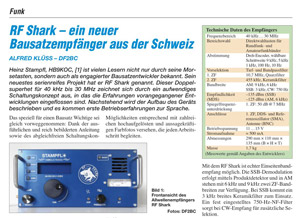|
Stampfl RF-Shark
In 2014, Heinz Stampfl (HB9KOC) launched its first Junior 1 receiver kit. Shortly afterwards followed the Junior 1D, which was much more complex and also more expensive. These kits were well received by amateur hobbyists, because by the well-thought-out concept, they were easy to build. Now there is a new receiver kit from Heinz. The RF Shark. This kit is intended more for the experienced hobbyist. Also good soldering skills should be available. At the bottom of the picture you can see all the parts that need to be installed. The many plastic bags contain around 500 components. Housing, cables and screws counted. Very important for a good success is a assembly instructions. This is of course the kit and is in my interpretation well done and clear. Here the >assembly instructions< can be downloaded.
As with the Junior 1 Kit, Heinz provided me with a fully assembled RF-Shark for testing. Alfred Klüss- DF2BC, built the RF-Shark and wrote a short report about it, which appeared in the journal Funkamateur. Here you can download the article. This is only in german. The contribution was kindly provided by Funkamateur.de.
Appearance / Quality With its side handles, the RF-Shark radiates a professional touch. The build quality is almost professional. The housing is made of blue anodized aluminum sheet, all knobs are made of black anodized aluminum. The laser engravings are exact and easy to read. All buttons and the S-meter are backlit. In order to look at the offal I once risked a look under the hood. For that I had to unscrew the device. The boards are kept in unusual white and look really cool. Usually you always get to see green boards. This device was assembled by Heinz himself. Everything looks properly processed. The screwing worked without problems, because the housing is quite fitting. The LCD display is the central element of the receiver. It has four rows of twenty characters, combined with good contrast and is also easy to read from the side. The RF-Shark can be tilted on the rear side by means of folding feet to bring it to a comfortable operating position. For a kit receiver, the RF-Shark offers exceptionally many connectivity options.
The RF-Shark is not a cheap kit! The parts used are of good to very good quality and sometimes better than those of commercially available finished equipment! As an example, Copal's optical rotary encoder for the VFO tuning knob.
Operation of the RF Shark The operation is very simple and does not need much study of the manual. With the buttons on the left side either the amateur radio bands (HAM) or the radio bands (RADIO) are selected. Depending on which band is set, the display shows its "meter band" display. The operating modes are changed with the "MODE" button. If the "MEMO" button is pressed before switching off the device, the last set parameters such as frequency and operating mode are saved. The next time these parameters are switched on, these parameters are reset automatically. The "STEP" button switches the step sizes. With "ATT" a 24dB attenuator is switched into the signal path. All functions are switched in carousel mode. The rotary knob "PRESELECTOR" is a specialty of the RF-Shark. For each major frequency change, the preselector must be readjusted by hand for the best possible reception. This has the great advantage that the receiver generates significantly fewer intermodulation products. In other words, he becomes a big signal. With the large tuning knob made of aluminum, the receiving frequency can be set silky soft thanks to the optical encoder. With "VOLUMEN" you can adjust the volume. Reception test
I had the RF-Shark on
the table for several weeks and compared it to my receiver park.
These were mainly the Winradio G33DDC Excalibur and the Icom
IC-R8600. The antennas used were the Stampfl Active Dipole, Datong
AD370, Reuter Kreuzloop and the UniWhip from DL4ZAO. The Tuning-software for the RF-Shark The RF-Shark is delivered as standard with a simple operating software. Dr. Ernst Kirschbaum (DL2EBV), a specialist in software and programming, recognized the potential of the RF-Shark and set about optimizing and expanding the operating software. The special version allows extended operation of the RF-Shark. Thus, for example, set the pulse rate of the encoder between 50 & 100 pulses per revolution and, among other things, activate 50 memories. The special firmware version 1.7 are not official and are only available on request from Heinz Stampfl for CHF 30.-. With this >Link< you can download the operating instructions of the extended firmware (only in German). Conclusion For the savvy hobbyist with patience, the RF Shark is easy to implement. After all, there are around 500 components to be installed. If the device is set up correctly, this good LMK offers reception and even the VLF range from 40KHz. Unfortunately, the bandwidth filters are a bit too broad. For heavily used radio bands, listening is often accompanied by an interference whistle. The built-in speaker provides acceptable sound, but can be used with a good external speaker, such as a speaker. The Bose Soundlink Mini, significantly improved. The overall processing of the device is of good quality and you can tell the heart's blood in it. An all-round successful kit that can be tuned with the special firmware still something! Posted: 01.12.2019
|


.jpg)
.jpg)


.jpg)
.jpg)
.jpg)
.jpg)
.jpg)

.jpg)

.jpg)
.jpg)

.jpg)